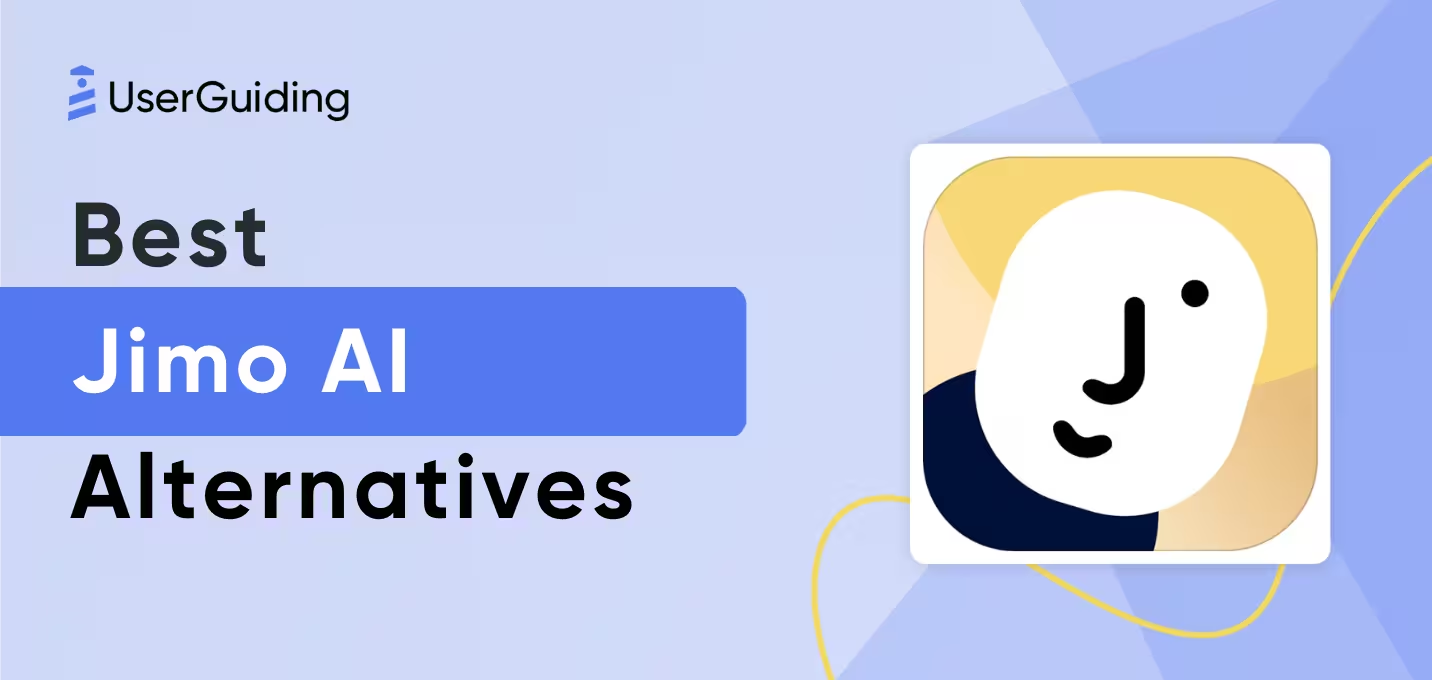

Investing in a digital adoption platform should feel like a smart move, not a leap into the unknown. But with Whatfix, pricing often feels so…
Unclear and confusing pricing tiers, limited information about feature limitations (and even feature offerings, in the case of Enterprise plans), plus a free trial promise that tricks you into giving your contact details and then forwards you to schedule a demo.
This article will:
- Cut through the pricing confusion by breaking down Whatfix’s plan details and key cost drivers
- Share real customer insights on pricing and product experience to see if Whatfix stands by what it offers
- Help you decide if Whatfix fits your needs or if a simpler, more cost-effective alternative would be a better choice
Here we go!
TL;DR
- Whatfix is a product suite made up of three solutions (Digital Adoption Platform, Product Analytics, and Mirror) that help you improve product experience, feature discovery, onboarding, in-app guidance, user support, and behavior analytics.
- However, Whatfix’s pricing lacks transparency. According to Vendr, the average cost is almost $32,000 per year, with many former customers reporting starting prices of at least $1,000 per month.
- Its complex pricing requires choosing separate plans for each solution and platform you need –one of the key reasons its costs can quickly add up.
- Is Whatfix worth the investment? It depends. The platform offers valuable features like flow diagnostics, strong contextual support, powerful analytics, and meets enterprise-level requirements.
- But it also has a steep learning curve, requires coding knowledge, involves ongoing maintenance and compatibility challenges, and lacks a free trial.
- If these downsides give you pause, consider a more user-friendly, modern, and engaging alternative like UserGuiding.
- UserGuiding is easy to learn, has a no-code editor, offers off-app tools for comprehensive engagement, and comes with transparent, cost-effective pricing.
- Plus, it offers a genuine free trial you can start today.
What is Whatfix?
Whatfix is a digital adoption solution that combines powerful product analytics, multi-platform support, and all the classic digital adoption tools like in-app flows, checklists, tooltips, and modals.
In reality, Whatfix is a suite of three distinct products:
- Whatfix Digital Adoption Platform (DAP) is the core offering. It's the most feature-rich product in the suite, providing in-depth capabilities for user onboarding, engagement, and support.
- Whatfix Product Analytics is an advanced analytics toolkit. While it’s often considered an add-on to the DAP, it’s sold separately and priced as a standalone product.
- Whatfix Mirror is a unique tool that creates sandbox-like, interactive environments ideal for training content, demos, or guided experiences without touching your live product or real data.

What is Whatfix used for?
Whatfix is a powerful and flexible platform that helps you create better user experiences, whether you're using the Digital Adoption Platform, Product Analytics, or Mirror solution.
Here are some of the key use cases for Whatfix and the features that support them:
- Onboard New Users: Guide first-time users through your platform using step-by-step interactive walkthroughs (Flows), contextual tooltips (Smart Tips), and interactive checklists (Task Lists) to accelerate learning and reduce drop-off.
You can use Whatfix’s in-app guidance features for employee onboarding, too.
- Personalize Experiences Across Platforms: Custom segment users based on role, behavior, or platform (mobile, desktop, web, OS) to deliver targeted, contextual in-app guidance that aligns with individual needs and environments.
- Enable Self-serve Support: Centralize help content inside your product with the Self Help widget, allowing users to search and access relevant articles, videos, and FAQs without leaving the app or contacting support.
- Collect User Feedback: Launch micro surveys at key touchpoints to gather real-time feedback and improve UX. Use built-in templates like NPS, CSAT, or custom surveys to assess satisfaction and usability.
- Announce Product Updates: Use attention-grabbing modals, banners, and beacons to communicate new features, updates, or changes directly within the app, ensuring users are always informed.
- Track Product Engagement: Analyze user behavior with detailed reports on funnels, user journeys, cohorts, and feature usage trends to identify drop-offs and optimize product performance.
- Train New Hires in Sandbox Environments (Mirror): Create safe, interactive simulations for employee onboarding or software training without exposing sensitive data or disrupting real workflows.
You can use Whatfix Mirror for customers, as well. For example, you can offer embedded simulations on your website or landing pages to demonstrate product value. It can be ideal for trial users or prospects evaluating your product.
- People-first AI Adoption: AI adoption, AI transformation, AI-first… These have been the buzzwords of the past two years. Many companies, especially SaaS companies, have adopted AI solutions (or started offering them). Whatfix is on the AI wagon too, but it doesn’t highlight that fact as loudly as some others.
What sets Whatfix’s approach to AI apart iss its people-first mindset.
Whatfix AI doesn’t blindly generate insights or automate workflows. Instead, it supports employees with intent-based prompts, offers reinforcement training at key friction points, and helps drive awareness where it matters most.
How much is Whatfix?
The short answer to this question is: “We don’t know, no one knows.”
Whatfix doesn’t have transparent pricing, which means they don’t disclose details about their plan costs, base pricing, or how pricing scales with user count or feature usage.
Thanks to (former) Whatfix customers who’ve shared their experiences on forums and review sites, we do have some insights.
According to Vendr, the average cost of Whatfix is $31,950 per year. However, it’s important to note that this figure is based on a limited number of purchases, so it may not accurately reflect broader pricing trends.
That said, you can safely assume that Whatfix sits on the higher end of the pricing spectrum.
But, cost alone isn't the only issue; the lack of pricing transparency can also lead to trust issues, uncertainty, and frustration during contract negotiations.
Based on customer reviews available online, here are a few other important points to consider about Whatfix’s pricing:
- Quick Signatures: According to Vendr community notes, Whatfix offers discounts if you agree to sign the contract within a short timeframe.
If you’re fully confident in Whatfix and just negotiating the details, this can work to your advantage.
However, if you're still unsure whether Whatfix is the right fit, this time-limited offer may pressure you into a decision you could regret later.
When the initial price is high, and you're still weighing the pros and cons, a discount (even if it doesn't bring the price down to the industry average) can cloud your judgment and make the solution seem more attractive than it truly is.

- Not for SMBs: According to former Whatfix prospects, Whatfix’s starting price is over $1,000 per month. So, not exactly budget-friendly, especially for small and mid-size businesses, let alone startups.
And if you’re not planning to use all the features the platform offers, like multi-platform support, for example, and you're only interested in the in-app experience management side of things, the pricing starts to feel ridiculously expensive for what you actually need.

- Still More Accessible than WalkMe: Whatfix is more expensive than many other Digital Adoption Platforms (DAPs) and user onboarding platforms. However, it’s not the most expensive option out there. So, prospects who compare it with alternatives like Pendo or WalkMe often still find it relatively accessible and within budget.

- Enterprise-level Customers Find the Prices Okay: While Whatfix isn’t accessible for most SMBs, enterprise-level prospects and customers often find the pricing reasonable, especially when weighed against the platform’s features and overall potential.

What are Whatfix’s pricing tiers?
As we’ve mentioned, Whatfix offers 3 separate solutions, each priced individually.
The most complex pricing structure is for Whatfix DAP, where you need to choose both your platform(s) and one of three base plans (for web and desktop applications, as mobile and OS have only one plan), each with different feature coverage and limitations.

Product Analytics and Mirror only work with web-based apps, so there’s no platform choice involved for them.
While Product Analytics still offers three different base plans, Mirror has only one plan, so it’s simply a matter of whether you want it or not, with no additional options.
Sounds complicated, we know.
Here’s a visual map you can follow to understand Whatfix’s pricing tiers:

Now, let’s take a look at the features and capabilities offered within these plans
Whatfix Digital Adoption Platform (DAP) Pricing Tiers (for Web & Desktop)
➡️ Standard Plan:
- Features: Self-help, flows, beacons, smart tips, launchers, task lists, pop-ups, template surveys, guidance analytics.
- Capabilities: Manual translation, SSO.
- Integrations: Limited to 2 integrations.
- Ideal For: Mid-size businesses that seek user onboarding features and in-app support essentials with detailed analytics capabilities.
➡️ Premium Plan:
- Features: Everything in the Standard plan, + custom surveys, engagement dashboards.
- Capabilities: Auto translation, SSO, auto testing, smart solutions (templates, ready-to-use integrations, etc.), offline mode for desktop end-users.
- Integrations: Available.
- Ideal For: Mid-market and larger companies that want more flexibility and control over in-app experience management features.
⚠️ Offerings of the Enterprise plan are not disclosed on Whatfix’s website.
Product Analytics Pricing Tiers
➡️ Standard Plan: (included in the Digital Adoption Platform)
- Features: 25 tracked end-user actions, custom dashboards, funnel insights, trends insights, user journey insights, cohorts.
- Ideal For: Businesses that want advanced analytics and reporting capabilities.
➡️ Premium Plan:
- Features: Everything in the Standard plan, + unlimited tracked end-user actions, adoption health dashboards (for user adoption metrics).
- Ideal For: Businesses that want comprehensive event tracking capabilities as well as advanced reporting capabilities.
⚠️ Offerings of the Enterprise plan are not disclosed on Whatfix’s website.
What impacts Whatfix’s pricing tiers?
Since Whatfix’s pricing isn’t transparent, it’s difficult to fully understand the impact of each pricing differentiator, especially when it comes to the difference between the Premium and Enterprise plans, as the added features for the Enterprise tier aren’t publicly listed on the website.
However, we can still make a pretty solid guess at what drives Whatfix’s prices up 👇🏻
- Platform selection (Web applications, Desktop, Mobile, OS)
- Base plan tier (Standard, Premium, Enterprise)
- Add-ons like Product Analytics or Mirror
- Support level and additional service agreements (Digital Adoption Assistant or Digital Adoption Program Manager)
- Contract length and urgency (quick-sign discounts)
- Language & localization support
- Hosting & deployment options
Is Whatfix Worth the Cost? (Pros & Cons)
The answer to this question depends on a bunch of factors. Whatfix packs a solid set of features and capabilities. Its advanced analytics can easily outperform many competitors, and its multi-platform support is honestly hard to beat.
But let’s be real: Product features alone rarely make or break a multi-year deal...
What really impresses (or drives a customer to the edge) is the quality of customer service, how easy the platform is to use, the maintenance experience, scalability, and how the product actually evolves over time.
Whether the platform actually delivers on its initial promises 👀
So, here’s what Whatfix customers love –and what they struggle with– after spending some real time with the platform:
Pros of Whatfix
To start on a positive note, let’s talk about the advantages first.
- Error Identification with Whatfix Diagnostics: Whatfix Diagnostics is a feature currently in beta that helps you identify and troubleshoot issues within your Flows or individual Flow steps.
It’s especially useful if you manage a large number of Whatfix Flows or make extensive use of Whatfix’s targeting and segmentation capabilities, in which case manually checking each Flow or step would be time-consuming and inefficient.
You need to contact the Whatfix support team to access the feature, though.
- Responsive Support: Almost all Whatfix reviews on G2 and Capterra highlight how responsive and helpful Whatfix’s customer support team is. Whatfix is a complex tool that often requires a fair amount of hand-holding (more on that in a minute), so many users mention reaching out to the support or customer success team multiple times.
And while that could easily lead to frustration, Whatfix’s team is so dedicated and easy to work with that customers actually remember these interactions as a positive part of their experience, not just a necessary hassle due to the platform’s complexity.

- Analytics and Real-time Guidance: Product analytics is a standalone solution within Whatfix, so it’s expected to be advanced, detailed, and more capable than the analytics features offered by other user adoption tools, especially the ones that prioritize in-app experiences and user engagement over data.
⚠️ That said, setting up analytics dashboards in Whatfix isn’t exactly no-code magic.
To configure them properly, you’ll need a solid understanding of data and some coding knowledge. It’s not as simple as picking a dashboard from a drop-down and watching the insights appear.
Many customers say that the analytics require technical expertise or at least support from teams like IT.

- Practical Extension/ Plug-in: Whatfix Studio, the Chrome extension/ plug-in of Whatfix, is considered visually pleasing and easy to use by many customers. You can start building directly from the extension and also customize the settings of your Whatfix content right there.
The plug-in allows you to manage your workspaces, preview content, and log out of your account as well, so it’s not just a feature builder.

- Meets Enterprise-level Expectations: Whatfix can handle the workload and workflows of large enterprises with complex platforms. While it can be challenging to update and maintain the Whatfix content (especially since UI changes sometimes require you to rebuild your in-app flows from scratch) many customers still say the tool is impressive for even allowing the creation of such intricate materials and workflows.

Cons of Whatfix
And now, the part where things get a little frustrating…
- No Chance of Trying It Out: None of Whatfix’s pricing plans offer a free trial upfront, instead, you’re encouraged to book a demo with the sales team. But if you explore their website a bit and land on the FAQ section under “Can I try Whatfix for free?”, you’ll see the answer is yes.
The catch? The link they provide to "start your free trial" actually leads you to a form where you enter your email and phone number (thinking it’s to create your free trial account)… only to be prompted to schedule a demo call afterward. So, it feels less like starting a trial and more like entering the sales funnel.

Total disappointment, total deception 👎🏻

- Steep Learning Curve: The average implementation time for Whatfix on G2 (based on customer reviews) is 3 months. And we’re talking about a busy, painful 3 months that pass with a lot of onboarding processes, support meetings, training content/ sessions, trials, and mostly errors.
Whatfix is not a no-code tool. It requires some coding knowledge, especially CSS and JavaScript. So if you don’t have a technical background, it can get even trickier.

- Code-heavy Customization: As we’ve just mentioned, Whatfix requires coding if you want to use the platform to its fullest potential, especially product analytics and customization capabilities.

- Maintenance Issues: Whatfix tends to get heavy as more content and materials pile up. So when you make updates or even small enhancements, maintaining the workflows/ flows can start to feel like a job of its own.

Here’s what another user on Capterra had to say about the same issue:

- Confusing UI: While Whatfix’s plug-in, Whatfix Studio, is considered very user-friendly, the overall platform UI, especially the dashboards, is often described by users as confusing and difficult to navigate.

- Feature Depth (or shallowness, should we say?): Whatfix offers a ton of features and functionalities, especially since it has three different solutions. But rather than focusing on improving the existing tools, like enhancing the feature builders or adding more templates, they seem to prefer announcing new features instead.

Here’s another customer voicing frustration with the underdeveloped features:

- Compatibility Issues & Unreliable Content: Whatfix is often chosen for its multi-app support, especially for desktop apps and OS, since mobile app support is offered by many other Digital Adoption Platforms (DAPs). And if desktop support is the main reason you pick a solution, you expect it to deliver reliable and stable content…
Several Whatfix customers have shared negative experiences online regarding compatibility issues. They report having to manually troubleshoot and rearrange all their Whatfix content with the help of the Whatfix support team.

A better alternative to Whatfix: UserGuiding
Whatfix is a solid platform, but there’s even a better one –UserGuiding!
UserGuiding is a no-code, all-in-one product adoption platform that allows you to create engaging product experiences for your users without writing a single line of code. It also offers features and capabilities for in-app communication, user research, product announcements, as well as self-serve support.
Here’s a comprehensive list of UserGuiding’s offerings:
- Product tours
- Onboarding checklists
- Hotspots and tooltips
- Announcement modals (banners, slideouts, pop-ups, etc.)
- NPS and custom in-app surveys
- AI assistant
- Resource center (in-app)
- Knowledge base (standalone)
- Product updates (standalone)
- Segmentation
- Analytics

As you can see, UserGuiding matches all the features offered by Whatfix DAP and even adds standalone features like a knowledge base and product updates on top. But let’s compare the 2 tools in more detail 🔎
- Usability & Implementation: UserGuiding is a no-code tool with an intuitive interface, while Whatfix requires coding for some features/ settings, and doesn’t have a very easy-to-navigate UI.
But the usability is not only about the UI, right?
UserGuiding has a little-to-no learning curve and a very short implementation time. In fact, you can start creating guides, tooltips, checklists, resource centers, and AI assistants almost right away!
And don’t just take our word for it, here’s what UserGuiding users say:

- Customization/Template Options: Both UserGuiding and Whatfix support brand customization and CSS styling. But where they really differ is in the flexibility and quality of the actual end-product design, especially templates.
Whatfix’s templates are limited in number and feel very outdated, particularly when it comes to surveys.

They don’t even look interactive; they’re more like static questions embedded in basic pop-up modals. On top of that, the types of questions you can ask in Whatfix’s in-app surveys are quite limited.
UserGuiding, on the other hand, offers a wider variety of modern, usable templates for announcement modals, surveys, and tooltips. Plus, the in-app surveys come with more flexible question types, giving you greater control over how you collect feedback.
Here’s a peek at the announcement modal templates:

And here is a survey template and its interactive preview in the survey builder:

- Standalone Features: UserGuiding offers a standalone knowledge base and a product updates page, which makes user engagement and communication more comprehensive. Whatfix doesn’t offer either of these features, not even anything remotely similar.
Instead, Whatfix supports integrations with external knowledge base tools, allowing you to pull support content into its resource center. But keep in mind, if you’re on the Standard plan, you only get two free integrations.
With UserGuiding, on the other hand, you can build and manage your own knowledge base directly within the platform, meaning that all your support content, both in-app and off-app, lives in one place.
Here’s how a knowledge base created with UserGuiding looks:

Another standalone feature UserGuiding offers for stronger user communication is the Product Updates page. This feature lets you centralize all your product announcements and update-related information (think release notes) in one place.
You can also collect user feedback directly on the page and turn your updates into a two-way conversation.

How much does UserGuiding cost?
UserGuiding has transparent, MAU-based pricing, letting you estimate your costs using an MAU slider right on the pricing page.
1:0 from the beginning, huh?
There are three paid plans, Starter, Growth, and Enterprise, plus a free plan called Support Essentials.

As the name itself suggests, Support Essentials is specifically for automated and self-serve customer support. In terms of features, you get an in-app resource center, a product updates page, and a knowledge base.
In addition to these, UserGuiding offers 50 free resolutions with the AI assistant in all of its plans, including the free Support Essentials plan. Material engagement reports and daily/weekly performance reports are available in this plan, too.
Integrations with Google Analytics, knowledge base tools, and live chat are also available in the free plan. So this isn’t one of those "free" plans that exist just for show, it actually has real, usable value.
If you're using UserGuiding purely for customer support, you won’t be missing anything with the free tier.
The paid plans are built for in-app user engagement and personalization.
Here’s the pricing breakdown:
Starter Plan
- $174/month (billed yearly) for up to 2,000 MAU
- $209/month (billed yearly) for 5,000 MAU
- …
Growth Plan
- $349/month (billed yearly) for up to 2,000 MAU
- $419/month (billed yearly) for 5,000 MAU
- …
UserGuiding offers a monthly billing option, too.
Though yearly billing saves 30% over the course of a year, UserGuiding doesn’t lock you into an annual contract if that’s not something you prefer. Just to give you a reference, for monthly billing, the prices of the plans are as follows:
- Starter Plan: begins at $249/mo for up to 2,000 MAU.
- Growth Plan: begins at $499/mo for up to 2,000 MAU.
UserGuiding’s paid plans are value-packed, just like the free plan.
The Starter plan provides access to essential tools such as guides, hotspots, surveys, checklists, a resource center, and basic analytics, making it a great option for small to mid-sized businesses. While it does impose limits on the number of active materials, it still covers most fundamental needs.
For teams that require more flexibility and sophisticated features, the Growth plan removes many of these limitations and introduces enhanced customization and optimization options. Features like custom CSS, A/B testing, goal tracking, and localization are also included in the Growth plan.
Both plans also include 50 free AI assistant resolutions, as we’ve mentioned earlier.
How do UserGuiding’s prices compare to Whatfix’s?
✅ More transparent with the cost calculations, as well as feature limitations
✅ Pricing scales more predictably with user growth
✅ More cost-effective
✅ More accessible, especially for SMBs
✅ More flexible with the monthly billing option available
✅ Free trial available so you can test the capabilities yourself
Final Thoughts: Choosing the Right Plan or Alternative
When picking a digital adoption platform, you want something that fits your unique needs without locking you into overpriced, overly complex solutions.
If you do have specific needs, like:
- Multi-platform support, especially for desktop and OS apps. Not many Digital Adoption Platforms (DAPs) cover these, so Whatfix stands out here. But be warned: compatibility issues are common, and you might find yourself frequently troubleshooting with their support team. Relying completely on Whatfix for smooth multi-platform performance? That’s still a gamble.
- Advanced analytics and reporting baked right in. Whatfix’s analytics are strong, especially for a DAP. If you want to avoid juggling separate tools for analytics and user adoption (and you’re fine paying for both Whatfix’s DAP and Product Analytics premium), plus you’re comfortable with some coding, it’s a solid choice.
- Sandbox-style training environments for complex software products, where you don’t want new users breaking anything during onboarding.
Then, Whatfix might just have the right plan for you as long as you can navigate the complexity and price.
But if those points don’t check your boxes, consider UserGuiding instead:
- UserGuiding lets you build user experiences without needing your tech team or constant hand-holding. You get more freedom to experiment, update, and optimize your content quickly and easily.
- The final user-facing content looks modern, interactive, and varied, far more so than Whatfix’s dated templates. Plus, customization with UserGuiding is better without being harder to use.
- And if you want to avoid sinking thousands into a complex, heavy, and hard-to-maintain tool, UserGuiding offers a more cost-effective, intuitive alternative with almost zero learning curve.
If you’re after a smoother way to support user adoption and engagement, UserGuiding just makes more sense. ✅
Frequently Asked Questions
How much does Whatfix cost for enterprise digital adoption in 2025?
Whatfix doesn’t share any pricing details publicly. You won’t find clear information about how much each plan costs or how features scale. However, Vendr reports that the average annual cost is around $32,000. Some users also say entry-level plans start at $1,000 per month, making it hard to estimate the cost without speaking to sales.
How do Whatfix’s pricing tiers and features compare for SMBs and large companies?
Whatfix’s pricing structure is not ideal for SMBs. The lack of transparency, combined with high starting costs, makes it difficult to budget or scale. Customers report entry pricing over $1,000 per month. For enterprises, it can offer value, but the differences between tiers are unclear, especially when it comes to feature caps.
How does Whatfix’s plan breakdown, including user onboarding, training, and customer support solutions?
Whatfix offers three separate solutions: DAP, Product Analytics, and Mirror. There are nine plans in total. The DAP plans handle onboarding, in-app support, and some basic analytics. Product Analytics plans focus on user behavior data and reporting. Mirror has just one plan and offers a simulation tool, mainly used for internal training. Each solution is priced and managed separately.
Is Whatfix pricing scalable for growing SaaS companies?
Not really, especially if you’re an SMB. The pricing isn’t transparent, and costs can climb quickly due to separate charges for each solution and unknown feature-based pricing. You won’t know what drives the cost until you speak with sales, which makes budgeting difficult. Reported starting prices are already high, so scaling with Whatfix can be limiting for smaller or growing SaaS teams.
How does Whatfix’s pricing compare to WalkMe and Pendo in terms of ROI?
Whatfix is more affordable than both WalkMe and Pendo. WalkMe’s average annual cost is around $79,000, while Pendo’s sits at approximately $48,000, according to Vendr data. Whatfix averages closer to $24,000 per year. On G2, Whatfix users report achieving ROI in about 11 months, compared to WalkMe’s 16-month timeline. While Whatfix offers better cost-efficiency, it may still require technical knowledge and maintenance.

















.svg)
.svg)
.svg)
.svg)
.svg)

.svg)
.svg)












.svg)
.svg)





.png)















